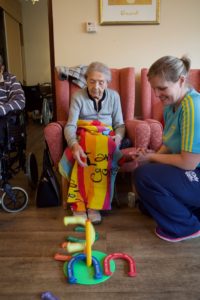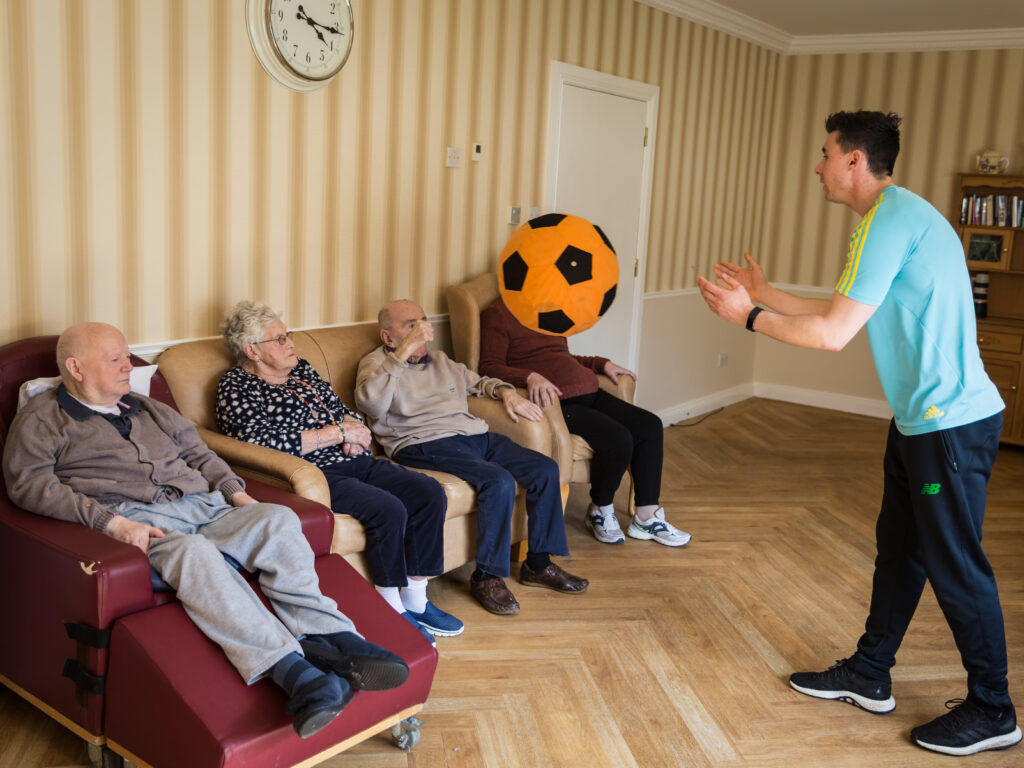FUELLING FITNESS IN NURSING HOME AND DAY CARE CENTRES
There are many misconceptions that older adults, specifically those of the age where they may be living in a nursing home or frequenting a daycare centre, shouldn’t practice regular physical activity. Over the last 8 years, Siel Bleu Ireland has been striving to change mindsets and help people understand the importance of exercising in a nursing home.
As a part of our Fuel for Fitness Campaign, today we will be discussing the importance of regular physical activity and a good diet for our oldest population; for people aged 75+ or our most dependent population who live in residential care or frequent daycare centres.

IMPORTANCE OF EXERCISING IN NURSING HOMES
You’ll be sick of us saying that you are never too old to exercise, but that really is the message we need to help decision makers and the older population themselves understand. The primary work of The Siel Bleu Association across Europe has focused on exercise for residential care. With over 21 years of experience in the field, we have developed a best practice to ensure our oldest population can practice physical activity that is both safe for them to do, and of course, effective.
How do we do this? Well, “Adapted Physical Activities” or APA is a fantastic tool used to design exercise specifically for people who cannot partake in traditional “one size fits all” exercise programmes for any number of physical or cognitive reasons.
Once adapted to suit the abilities and needs of participants, exercise can be safe and beneficial for all. This is what the founding fathers of Siel Bleu understood and how the organisation can be.
Over the years we have tested the efficacy of Adapted Physical Activities on nursing home residents through studies such as our European Commission funded study HAPPIER.
One of the most important things that physical activity promotes is prevention. Prevention is key to stop accidents and injuries happening to older adults and to slow the progress of an age-related disease. In Ireland, the cost of falls and fractures has amounted to €1billion per year by 2020 and €2billion per year by 2030. One of the most common injuries that result in stays in the long-term residential accommodation is falling.
Falls are also one of the biggest concerns for nursing home residents. Not only do they cost a considerable amount, but the implications for an older adult can be devastating. A fracture occurring fall can result in long waits in A&E, surgery, convalescence let alone the psychological ramifications, loss of confidence and independence.
Whether in a nursing home, living at home, or frequenting a daycare centre, exercise is and should be a vital part of a person’s life. But, in order to fuel that fitness, what should we be putting into our bodies?
WHAT SHOULD I EAT TO KEEP MYSELF HEALTHY?
While most people living in residential accommodation will have their food prepared for them, this may not be the case for all older adults. If you’ve just come home from your daycare centre, you need to decide what to cook for tea. What should you bear in mind for your optimum health?
- The recommended caloric intake for moderately active older women is 1800kcal per day and 2200 – 2400kcal for men. That’s about 800kcal for men and 600kcal for women per meal.
- Good Fats – Foods which are low in trans and saturated fats help to reduce the risk of heart disease. It is recommended to have oily fish twice a week. Trying cooking it with herbs and spices to reduce sodium intake. An alternative to salt will be paprika, lemon juice and dill.
- Fibre – Eating foods rich in fibre will help you to stay regular. It also helps to reduce the risk of heart disease and prevent Type 2 diabetes. When cooking pasta or eating bread, you might want to switch to wholemeal. It might take a little more time to boil than the white variety, but it’s worth it as it has far superior health qualities for your health.
- Nutrient-rich food –
- Have you tried a sweet potato? As opposed to their white counterparts and as the name suggests they have a naturally sweet taste. Not only are they low on the Glycaemic Index, it keeps you feel fuller for longer.
- Load your plate with vegetables. As a veggie lover, I will make sure that my plate has as many colours as possible. When vegetables are cooked for too long, the vitamins (B & C) will leach into the water. To reduce leaching, use less water and cook for less time, or drink the water used to cook the vegetables. If you are planning to drink the water, do not add salt when boiling. If the idea of drinking carrot water puts you off, you can use the water to boil pasta or rice instead.
- Vitamin B12 – people over the age of 50 typically don’t consume enough Vitamin B12. Fortified cereals, lean meat and some seafood are sources of B12. Ask your GP if you need a supplement.
- Protein and dairy are important for older adults. It keeps the bones strong and strong bones means better movement. I should say that lean meat is recommended. Try to season the meat with herbs and spices because it is important to keep the sodium level to the minimum.
- It is really important to keep yourself hydrated. As you age, it is hard sometimes to know when your body is dehydrated. I suggest that you keep an alarm to remind yourself to drink water at a certain time. Have a sit and sip the water. It will be even better if the water is lukewarm. (Consult your GP if you are to limit fluid intake)
**Disclaimer: The advice given in this blog is meant as a suggestion only. It is important to ask your doctor/dietitian before making any changes to your lifestyle.


